This post may contain affiliate links. Please read our disclosure policy.
These Auntie Anne's-style gluten free soft pretzels with sweet mustard dipping sauce will keep you from having “just one” gluteny pretzel at the mall!

Table of Contents
- Why this recipe for homemade soft gluten free pretzels is so special
- Tips for making the best homemade gluten free soft pretzels
- How to make gluten free soft pretzels
- Tips for baking gluten free soft pretzels right the very first time.
- Gluten free soft pretzels ingredients, substitutions, and necessary equipment
- FAQs
- How to make homemade gluten free soft pretzels, step by step
- Gluten Free Soft Pretzels | Auntie Anne's Style Recipe
Why this recipe for homemade soft gluten free pretzels is so special
I haven't had an Auntie Anne's pretzel in the mall in, like, 100 years. But Auntie Anne's pretzels are like Cinnabon. You can't help but get something of a contact high if you set foot in a mall that sells them.
That buttery, salty goodness just lives there permanently. Just ask the tired parents waiting in line at that pretzel counter on any given Saturday in America. You can't escape it. Well, when you're gluten free, clearly you must escape it.
Boiling the pretzels in a baking soda bath, like boiling bagels, is what gives them that chewy exterior. They wrinkle up, but don't worry! They plump right up when you bake them.
Auntie Anne's pretzels are thinner than I made mine, but I found that when I rolled them super super thin, they didn't hold their shape very well during boiling. Who knows what kind of black magic those Auntie Anne's people do with their super skinny pretzels.
How to store homemade gluten free soft pretzels for later
If you don't plan to serve all of these gluten free soft pretzels right after baking, try salting only the ones you intend to serve. Then, moisten and salt the other ones right before serving.
They freeze quite well after baking and cooling. Just wrap them tightly in a freezer-safe wrap and freeze. Defrost at 50% power in the microwave and then warm in a toaster oven, then serve!
And by the way I'd be remiss if I didn't tell you that I've got 8 brands of packaged gluten free pretzels for you to try. None are soft pretzels, they're the crunchy kind, but thankfully there are lots to choose from on the market today.
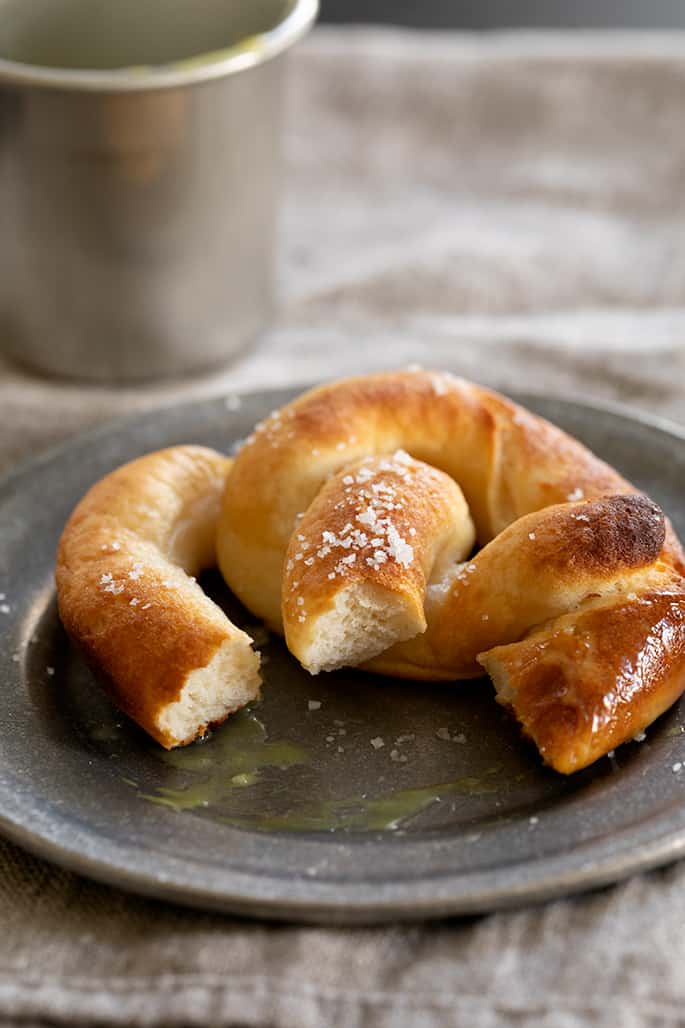
Tips for making the best homemade gluten free soft pretzels
How (and why) to boil gluten free soft pretzels
The most common difficulty in making any yeasted boiled bread like bagels or pretzels is making sure that the shaped, risen dough doesn't fall apart during boiling. Bagels and pretzels are boiled for similar reasons but in different water-based solutions.
Boiling bagels and soft pretzels (or pretzel rolls) is what gives them that hard, chewy exterior. Bagels are traditionally boiled in a bath of water and barley malt syrup. Our gluten free substitute is a molasses bath, which does a good job of mimicking the color and flavor of the barley malt bath.
Pretzels are traditionally boiled in a highly diluted solution of lye (or sodium hydroxide, which is also used to make soap), which requires extreme caution and rubber gloves. I'm all for DIY, clearly, but let's not be ridiculous. A baking soda bath does a reasonable approximation of ensuring a nice deep color on the outside of your pretzels after baking.
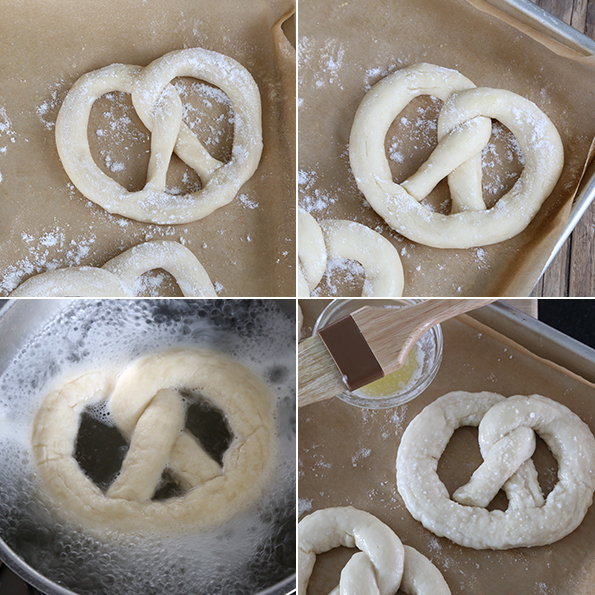
How to make gluten free soft pretzels
Making gluten free soft pretzels has 3 main steps: making the raw dough then letting it rise and chill, shaping it and letting it rise again, then boiling and baking the dough. Since, like gluten free bagels, pretzel dough is boiled before it’s baked, that’s an extra step but it’s well worth your time.
Boiling the bagels helps control the rise, so they stay chewy, and brown when they bake because we boil them in a baking soda bath and the alkaline solution aids browning.
Make the pretzel dough.
This is the most straightforward part, and as long as you use the right ingredients and you’ve measured them accurately by weight, you can’t mess this part up! Whisk together all of the dry ingredients (gluten free flour blend with xanthan gum, tapioca starch, buttermilk powder, yeast, cream of tartar, baking soda, and brown sugar) in the bowl of a stand mixer.
Then, whisk in the salt. Next, add the wet ingredients (apple cider vinegar, butter, egg whites, and milk) and beat with the paddle attachment until the dough is so well-combined that it begins to get irregular and look sort of whipped.
We’ll let the dough rise, covered tightly, before shaping it so that it develops some flavor and the flour can absorb some of the liquid to make it easier to handle. We’ll even chill the for a bit, which will also make it easier to handle. We don’t want it to rise for too long, though, or it tends to be harder to control the rise after shaping.
Shape the dough into pretzels.
Now, the dough is ready to be shaped into that twisted pretzel shape. We don’t want to add too much additional flour to the dough during shaping, or we’ll lower the hydration ratio and the dough won’t rise (yeast needs enough moisture to be active).
Divide the dough into 8 equal pieces by using a metal bench scraper or sharp knife to cut it in half, then half again, and finally half again for 8 equal pieces.
Working with one piece at a time, here’s how we’ll create that pretzel shape: roll the dough into a 12-inch rope, then curve it into an upside down “U” shape; criss cross the ends over one another into an “X” shape about 3 inches away from each end, then grab each crossed end with the opposite hand, criss-cross them once. Finally, turn them over onto the round end of the original U shape, and press the ends down to help them adhere so the twist doesn’t unravel during boiling.
Cover and let the raw soft pretzels sit just until they’re beginning to rise. This is one particular dough that can easily overproof.
Boil and bake the bagels.
Create a baking soda and salt water bath in a large pot, and bring it to a rolling boil on the stovetop. Place the risen pretzels gently in the boiling water and, without crowding each other, let them boil for about 1 minute each. Don’t flip them so you don’t risk disturb the shape. Instead, gently immerse them in the boiling water so the tops boil, too.
All that’s left is to return the boiled pretzels to a lined baking sheet, brush them with butter, sprinkle with salt, and bake at 400°F until they’re golden brown all over.

Tips for baking gluten free soft pretzels right the very first time.
How to make sure your soft pretzels don't fall apart during boiling
There are three ways to ensure that your soft pretzels don't fall apart during boiling. The first is to ensure your baking soda bath is at a full, rolling boil before you add the shaped, risen pretzels. A slow boil will do little to seal the outside of the pretzel, and will just sort of cause it to wilt.
Second, do not overproof the dough. This is a rare case of yeast bread baking in which you should only allow the shaped, raw pretzels to rise until they seem merely swelled, and not even necessarily risen to 150% of their original size.
Overproofing is not a function of just time but is rather determined by amount of rising. If the environment in your kitchen is cold and dry, yeast dough will rise more slowly. If it's warm and humid, more quickly.
Finally, if you boil the pretzels for too long, you risk their beginning to dissolve in the water. Err on the side of less boiling, rather than more. The dough is enriched enough and wet enough that the pretzels will still be tender inside.
Sometimes, wait to salt the outside of your soft pretzels
If you don't plan to serve all the pretzels immediately after baking, consider baking without the coarse salt entirely, or with a very light sprinkling of it. Salt on the top of bread draws moisture out of the bread and causes it to go stale more quickly.
The salt in the bread dough itself is essential for controlling the yeast production and, more importantly, for taste. Bread without any salt is bread for the trash bin. If you do eliminate the salt sprinkled on top of the pretzels during baking, simply brush them with more melted butter and sprinkle with coarse salt before serving.
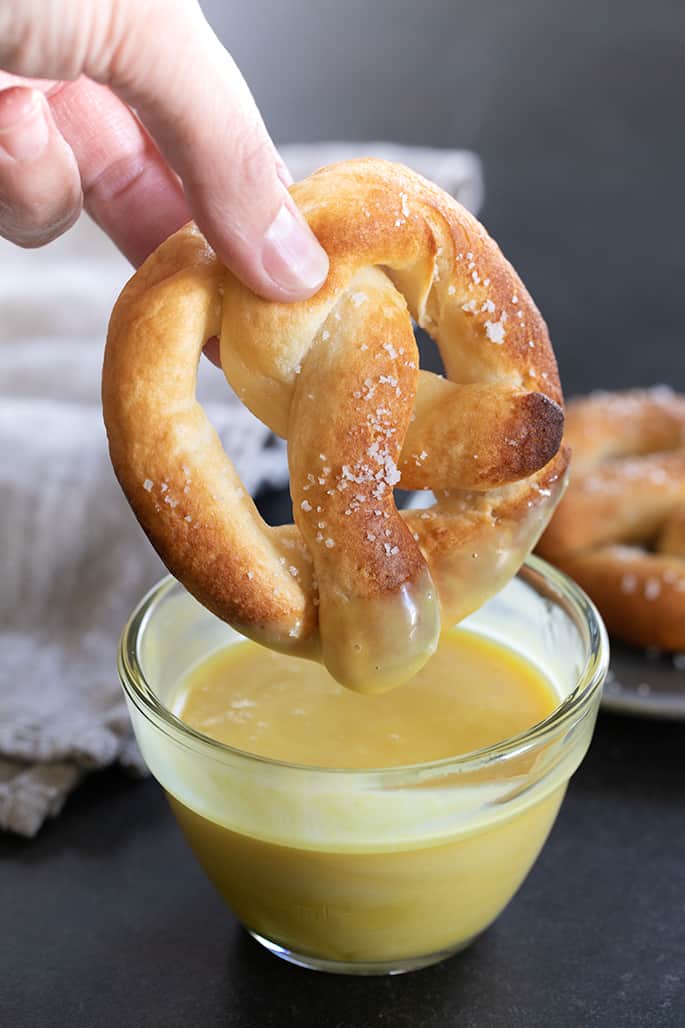
Gluten free soft pretzels ingredients, substitutions, and necessary equipment
Gluten free dairy free soft pretzels
If you need to make this recipe dairy-free, in addition to the buttermilk powder, you’ll have to replace the butter. In place of the butter in the dough and for brushing on the pretzels before baking, try using Earth Balance buttery sticks or virgin coconut oil.
Buttermilk powder
If you can’t find buttermilk powder, you can use nonfat dry milk powder in its place. It doesn’t add as much richness, but the recipe will still work. If you need to be dairy-free, you can try replacing the buttermilk powder with powdered coconut milk.
Gluten free egg free soft pretzels
There are two egg whites in the bread dough recipe. I haven’t tried replacing them, and I’m afraid I’m really not sure what, if anything, would work in their place.
How to replace the tapioca starch/flour
The addition of tapioca starch/flour to the bread dough helps make it stretchy and tender. In its place, you can try using arrowroot.
Cream of tartar
The cream of tartar can be replaced with 1/2 teaspoon of lemon juice or white wine vinegar.
Stand mixer
If you don't have a stand mixer, you may be able to use a food processor to make the dough, especially if you have a plastic attachment, rather than the metal blade. All you do, essentially, is dump the ingredients, in the order listed in the recipe, into the bowl, and let the mixer process it fully.
If you have access to a stand mixer, though, it's really the best way to make a smooth, integrated dough that is relatively easy to shape, boil, and bake.
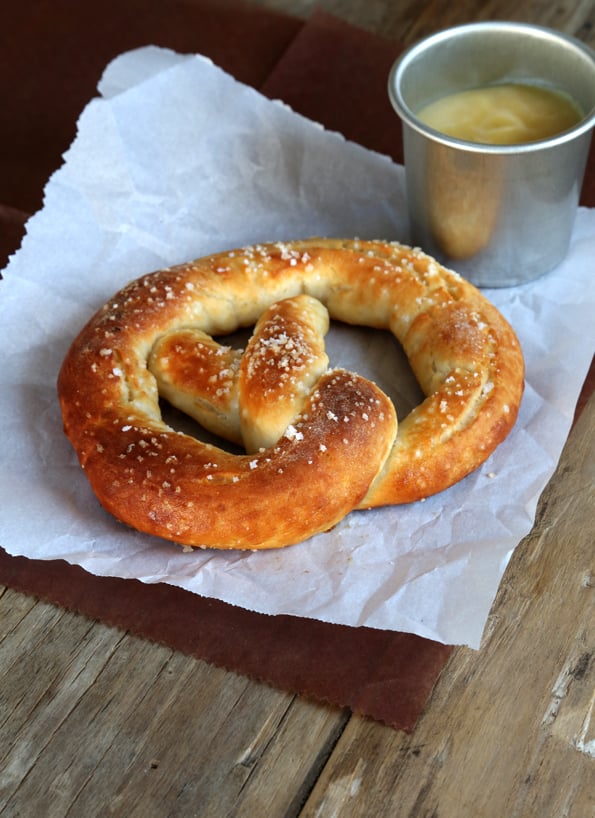
FAQs
No! Soft pretzels are made almost exclusively from wheat flour, which is a gluten-containing flour. If you use a recipe specifically made for gluten free pretzels, they'll be safe for anyone with a gluten intolerance.
Yes, you can make these soft pretzels without boiling them first, but they'll be missing their deep brown color, slightly crisp exterior, and will rise more unevenly and haphazardly.
No! Auntie Anne's does not make any pretzels that don't contain wheat flour.
Yes! The delicious, aromatic soft pretzels you can buy all over the city and surrounding areas of Philadelphia, Pennsylvania are made with wheat flour. It's a pity, but use this recipe for gluten free soft pretzels and you won't be sad any more!
Yes, after these pretzels are fully baked and cooled, they can be frozen for up to 3 months in an airtight freezer-safe container. But I wouldn't salt them on top if you know that you're going to freeze them, since the salt on top draws moisture out of the pretzels and makes them go stale faster. Defrost them in the microwave or toaster oven, but first sprinkle them with water so they are refreshed!
Yes! Every good rice-based all purpose gluten free flour blend has tapioca starch in it. We are adding more tapioca starch here because it creates special stretchy properties that make this dough easier to handle when raw, and improve the texture and mouthfeel once boiled and baked. You should never leave out an ingredient in a recipe.
How to make homemade gluten free soft pretzels, step by step
Gluten Free Soft Pretzels | Auntie Anne's Style
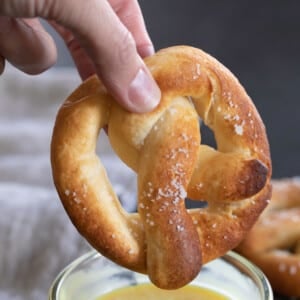
Equipment
- Sealed bucket for proofing dough.
Ingredients
For the soft pretzels
- 3 cups (420 g) all purpose gluten free flour blend, (I used Better Batter; please click through for details on appropriate blends), plus more for sprinkling
- 1 ½ teaspoons xanthan gum, omit if your blend already contains it
- ¼ cup (36 g) tapioca starch/flour
- ½ cup (43 g) Saco cultured buttermilk blend powder
- 1 tablespoon (9 g) instant yeast
- ¼ teaspoon cream of tartar
- ¼ teaspoon baking soda
- ¼ cup (55 g) packed light brown sugar
- 1 teaspoon (6 g) kosher salt
- 1 teaspoon apple cider vinegar
- 4 tablespoons (56 g) unsalted butter, at room temperature
- 2 (50 g) egg whites, 50 g, at room temperature
- 1 ⅝ cups (13 fluid ounces) warm milk, (about 95°F)
- Baking soda bath for boiling, 6 cups water + 1 tablespoon baking soda + 1 teaspoon salt
- Coarse salt for sprinkling
- Melted unsalted butter, for brushing
- Coarse salt, for sprinkling (See Recipe Notes)
For the sweet mustard dipping sauce
- 6 tablespoons mayonnaise
- 1 tablespoon Dijon mustard
- 3 tablespoons honey
- ¼ teaspoon kosher salt
- ½ teaspoon dry mustard powder, optional
Instructions
Make the pretzel dough.
- In the bowl of a stand mixer fitted with the paddle attachment, place the flour, xanthan gum, tapioca starch, buttermilk powder, yeast, cream of tartar, baking soda, and brown sugar, and whisk to combine well, breaking up any lumps in the brown sugar. Add the salt, and whisk again to combine.
- Add the apple cider vinegar, butter, egg whites, and milk, and mix to combine well. Turn the mixer speed up to medium-high and then high speed and beat until the dough almost seems whipped.
- The dough should pull away easily from the sides of the bowl when you use a silicone spatula to scrape it down.
Let the dough rise, refrigerated.
- Transfer the dough to a lightly oiled bowl or proofing bucket large enough for the dough to rise to nearly double its size. Spray the top of the dough very lightly with cooking oil spray.
- Cover the bowl very tightly with an oiled piece of plastic wrap or the oiled top of your proofing bucket. Place the dough in the refrigerator for at least an hour and up to 24 hours.
Shape the prepared dough.
- When the dough is ready, line rimmed baking sheets with unbleached parchment paper and set them aside. Turn the dough out onto a lightly floured surface, sprinkle it lightly with a bit more flour, and turn it over on itself a few times until it’s smoother.
- Using a bench scraper or large knife, divide the dough into 8 equal portions, each just under 4 ounces, and roll each into a ball.
- Working with one piece of dough at a time, roll into a thin rope about 12 inches long, pressing down and out with your palms and sprinkling lightly with flour to prevent sticking. Create an upside-down U shape with the dough, and cross the two ends over one another into an X shape about 3 inches away from each end.
- Grab each crossed end with the opposite hand, criss-cross them once, then turn them over onto the round end of the original U shape. Press the ends onto the round end to adhere. You can moisten the ends a bit to help them stick as they rise.
- Transfer the shaped pretzels to the prepared baking sheets, placing them about 2 inches apart from one another. Cover with lightly oiled plastic wrap and set in a warm, draft-free location to rise until just beginning to swell (about 30 minutes). Do not overproof.
Make the dipping sauce.
- Combine all the ingredients in a medium-sized bowl, and whisk to combine well. The dry mustard powder really gives the sauce a nice depth of flavor, but it is entirely optional. Set the sauce aside.
Boil and bake the risen pretzels.
- As the dough nears the end of its rise, preheat your oven to 400°F.
- In a large pot, make the baking soda bath by dissolving the baking soda and salt in approximately 6 cups of water, and bringing it to a rolling boil over medium-high heat.
- Once the dough has finished rising, place the pretzels a few at a time in the boiling baking soda bath for less than one minute total. Rather than flipping the pretzels to boil on both sides, press gently on the top of each pretzel to immerse the top in the water.
- Remove the pretzels with a strainer and return them to the baking sheet. Brush generously with the melted butter, sprinkle with coarse salt.
- Place the baking sheet in the center of the preheated oven. Bake until golden brown all over (about 15 minutes). Remove from the oven serve warm with the dipping sauce.
Video
Notes
Nutrition
Nutrition information is automatically calculated, so should only be used as an approximation.

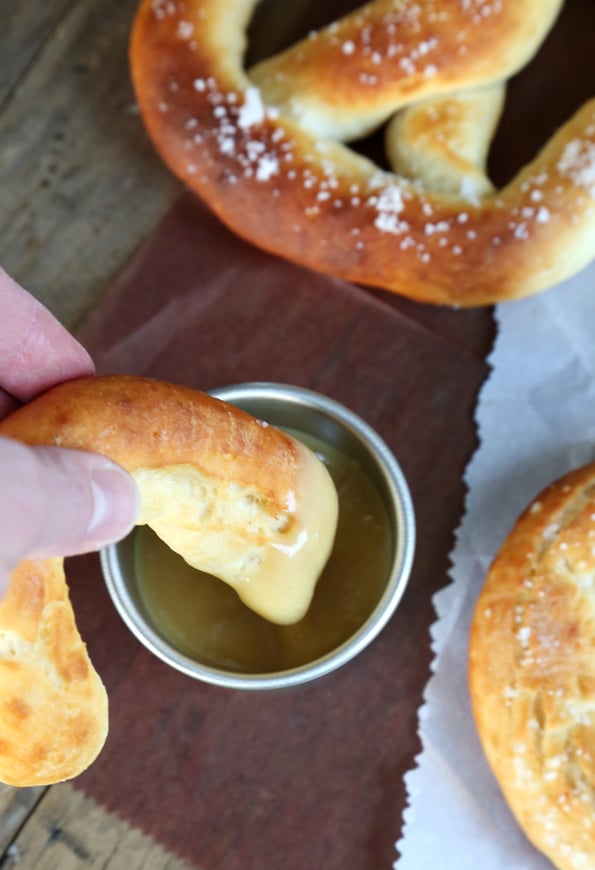

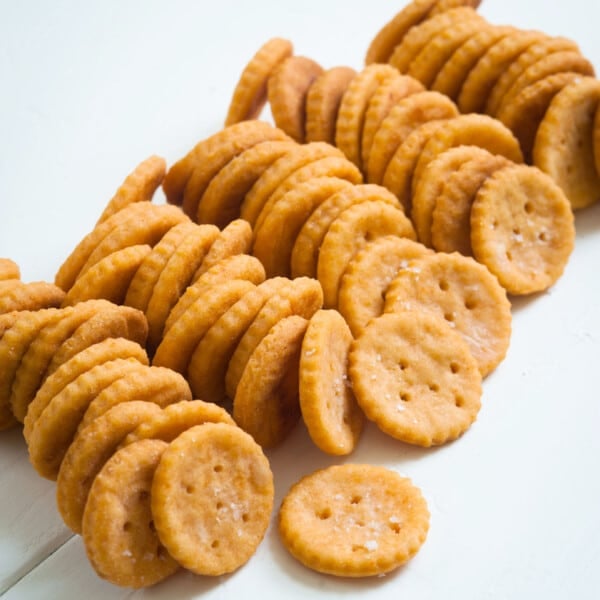


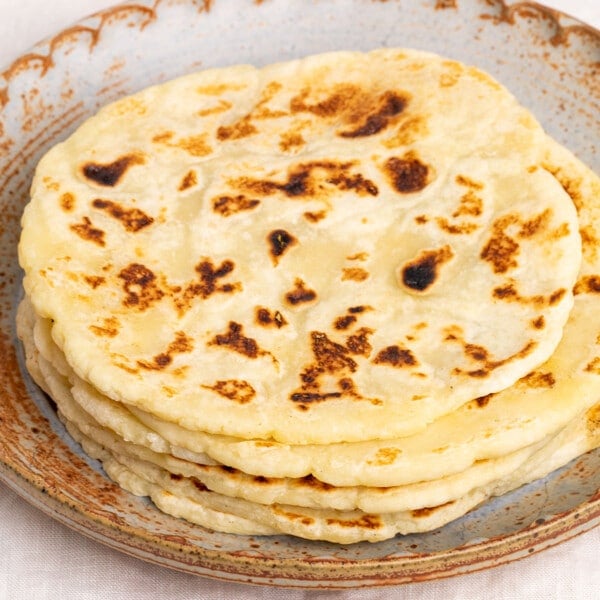









This looks amazing. Going to try next weekend for an Oktoberfest party for my wife who has celiac. Do you think I could use Better Batter Artisan blend flour mix for this recipe?
Hi, Shawn, I’m afraid I don’t like that flour blend at all. I can only recommend the original Better Batter all purpose blend.
My dough turned out like cake batter instead of dough. I used a scale to measure things so I am not sure how you got your dough so perfect. I must have done something wrong. I have made regular pretzels dozens of times without fail but unfortunately I haven’t been able to get this recipe to work for me.
Thelma, cake batter sounds like a result of a poor quality, unbalanced flour blend that I recommend against, like perhaps Bob’s Red Mill, although you didn’t say. Please click through to the all purpose gluten free flour blend page for information on what blends are appropriate. It’s linked to that ingredient in this recipe as it is in all recipes that call for such a blend. I’m afraid any experience with conventional yeast bread dough will not be instructive here at all, and as we are fundamentally replacing wheat flour, the flour blend must be appropriate.
Thank you for such a delicious recipe!
You’re so welcome, Cynthia!!
I’ve been hesitant to do any gluten free breads since my wifs learned she was allergic to wheat 7years ago. Decided to give thsse a try because she was pining for soft pretzels. While they aren’t even in the oven yet J already want to ask a question. What does “the almost whipped” dough look like? I thought I did it right but after chilling 2 hours this dough was too loose to roll. I worked more flour in there but I think it went to far the other way. I want to try again (because I fear this batch is lost) but any guidance would be appreciated! Is there a time of beating to shoot for?
Hi, Matt, I recommend you watch the video for more guidance on appearance. If you can’t see the video, you’ll need to turn off your ad blocker or it won’t be visible. If your dough was very loose, that sounds like an issue with ingredient substitutions (if you’re not using one of my recommended flour blends, for example, as some simply won’t work) or not measuring by weight. Volume measurements are inherently unreliable. Good luck!
I just have to say…I’m SO grateful to have found your recipes. Your yeast free pizza dough is now a family favourite and we have our vegan, gluten free pizza every Saturday for dinner. It’s so nice having pizza again! I’m not sure this is even possible or if you’ve already done this (if not, consider it a challenge? haha!!), I’d LOVE to see a gluten free, yeast and sugar free pretzel recipe! I’ve been missing pretzels! *cries* I’ve been diagnosed with this stomach issue called SIBO that makes it so I’m not allowed to have sugar (minus honey) or yeast and every pretzel recipe I find has yeast. If you’d ever consider tackling this, I’d be eternally grateful!
Aw, Dianna, that’s really tough. I actually do happen to have a number of yeast-free bread recipes here on the blog. I haven’t tried yeast-free pretzels, but I think you’d really find the Weight Watcher’s-style bread recipes I’ve published useful (just search “Weight Watcher” on the blog). And this yeast-free GF dinner roll recipe would be perfect for you, too. I didn’t realize that you can’t have sugar on a SIBO-friendly diet. The keto-friendly recipes (just use the search function again) should work for you, too. I hope that’s helpful! ?
These were a huge hit with my family. We have never tried Annie’s, but I can’t imagine that they are as good as these!
That’s so awesome!
Hi! Can’t wait to try this recipe? Do you need to use xantham gum with the better batter flour? Just making sure I pick some up at the store I’d i need it. Thank you!
Nope, Becky! If you use Better Batter, you’ll omit the xanthan gum in the recipe. Enjoy!